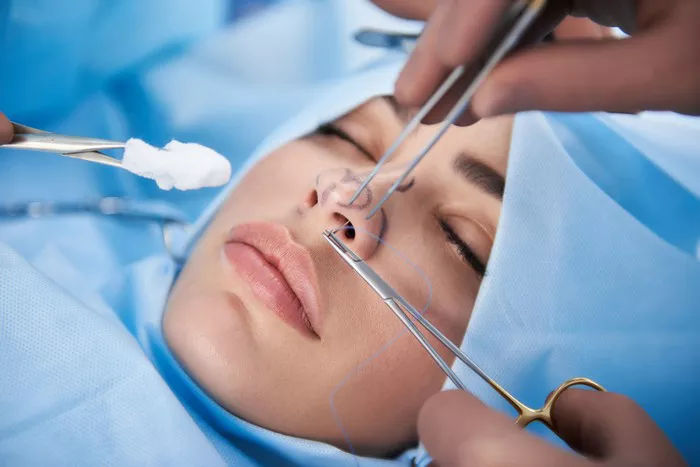Rhinoplasty, commonly referred to as a “nose job,” is a surgical procedure that can significantly alter the appearance and function of the nose. Whether you are considering rhinoplasty for aesthetic reasons or to improve your breathing, it’s essential to understand the various types of nose jobs available. In this comprehensive guide, we will explore the different types of nose jobs, their purposes, and what you should know before undergoing this transformative surgery.
Cosmetic Rhinoplasty
Cosmetic rhinoplasty is perhaps the most well-known type of nose job. It focuses on enhancing the aesthetic appearance of the nose, achieving harmony with the rest of the facial features. Here are some common goals of cosmetic rhinoplasty:
a. Nasal Bridge Reshaping: Many individuals seek cosmetic rhinoplasty to modify the nasal bridge, addressing issues like humps, bumps, or irregularities.
b. Nasal Tip Refinement: Some people opt for rhinoplasty to refine the shape, size, or projection of the nasal tip.
c. Nasal Width Reduction: Cosmetic rhinoplasty can also reduce the width of the nose, creating a more balanced facial profile.
d. Correction of Asymmetry: It can correct asymmetry, making sure the nose is aligned and balanced with the rest of the face.
Functional Rhinoplasty
Functional rhinoplasty focuses on improving the functionality of the nose. This type of nose job is often recommended for individuals who have structural issues affecting their breathing. Key objectives of functional rhinoplasty include:
a. Septoplasty: This procedure corrects a deviated septum, which can obstruct the nasal passages and impede airflow.
b. Turbinate Reduction: Enlarged turbinates, small structures inside the nose, can be reduced to alleviate nasal congestion and improve breathing.
c. Nasal Valve Repair: Problems with the nasal valves, which control the flow of air through the nostrils, can be addressed to enhance breathing.
d. Fracture Repair: In cases of nasal fractures, functional rhinoplasty can realign the nasal bones to restore proper function.
Revision Rhinoplasty
Sometimes, individuals who have previously undergone rhinoplasty may be dissatisfied with the results or experience complications. Revision rhinoplasty is a specialized procedure designed to correct and improve the outcomes of prior nose surgeries. Key aspects of revision rhinoplasty include:
a. Correcting Aesthetic Concerns: Revision rhinoplasty can address aesthetic issues such as asymmetry, irregularities, or disproportionate results from previous surgeries.
b. Functional Improvements: In cases where prior surgeries compromised nasal function, revision rhinoplasty can restore proper airflow and breathing.
c. Enhanced Precision: Revision rhinoplasty requires a high level of skill and expertise, as the surgeon must work with altered nasal anatomy.
Ethnic Rhinoplasty
Ethnic rhinoplasty recognizes that different ethnic groups have unique facial features and nose structures. The goal of ethnic rhinoplasty is to preserve a person’s cultural identity while enhancing the nose’s appearance or function. It aims to create a natural-looking result that complements the patient’s ethnicity. Common considerations in ethnic rhinoplasty include:
a. Respect for Cultural Differences: Surgeons must be sensitive to the patient’s cultural background and strive to achieve results that align with their ethnic identity.
b. Nasal Features: Ethnic rhinoplasty may involve modifications to the nasal bridge, tip, or overall shape to achieve a harmonious balance with other facial features.
c. Functional Improvements: In some cases, ethnic rhinoplasty may also address functional concerns, such as breathing difficulties related to the nose’s structure.
Non-Surgical Rhinoplasty
For those seeking temporary or less invasive changes to the nose, non-surgical rhinoplasty is an option. This procedure uses dermal fillers, typically hyaluronic acid-based, to reshape and refine the nose without surgery. Non-surgical rhinoplasty can address issues like:
a. Dorsal Hump Reduction: Fillers can camouflage a dorsal hump, creating a smoother nasal profile.
b. Nasal Bridge Augmentation: By strategically adding filler, the nasal bridge can be augmented to achieve the desired shape.
c. Nasal Tip Refinement: Non-surgical rhinoplasty can refine the nasal tip, making it appear more defined and lifted.
d. Correction of Minor Asymmetry: Fillers can be used to correct minor asymmetry or irregularities.
Conclusion
Rhinoplasty offers a wide range of options to individuals seeking to enhance the appearance and function of their noses. Whether you’re interested in cosmetic improvements, functional enhancements, or revision of a prior surgery, it’s essential to consult with a board-certified plastic surgeon who specializes in the specific type of nose job you desire.
Before undergoing any type of rhinoplasty, thorough consultation with your surgeon is crucial. They will assess your individual needs, discuss realistic expectations, and create a personalized treatment plan to achieve your desired outcome. Understanding the different types of nose jobs empowers you to make informed decisions about the best approach to meet your goals and ensure a successful rhinoplasty experience.


